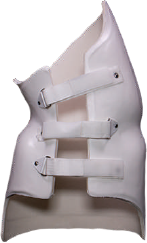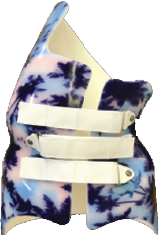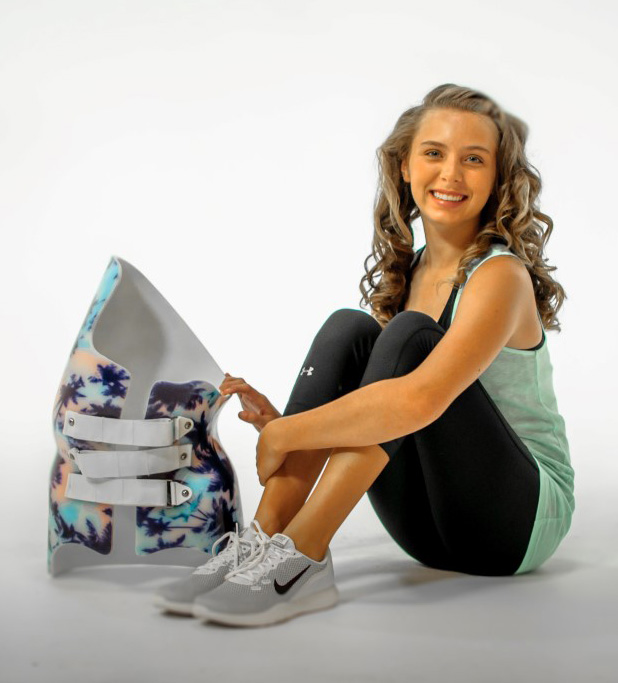Scoliosis management and the Charleston Bending Brace®
Many young people experience anxiety when learning they have scoliosis and are concerned about how it might affect their lives. Often, they find comfort in learning that they are not alone. Over 2.5 million young Americans have been diagnosed with idiopathic adolescent scoliosis. The information provided here offers straightforward answers to some of the most frequently asked questions from patients, their parents and their friends. Equally important we explain how the night-time-only Charleston Bending Brace can help treat what may seem like a very scary condition with minimal inconvenience. By working with the orthotist, doctor and the CBB team we hope to make the treatment process much more manageable.
What is Scoliosis?
Simply defined, Scoliosis is a sideways curve of the spine measuring more than 10°. We don’t understand why, but scoliosis effects girls 7 times more often than boys. The word “idiopathic,” means of unknown cause. An x-ray is used to determine the type and seriousness of a curve. Lateral curves can range from very mild to more severe and may resemble the letter “S” or a long letter “C”.
Recommended Books for a Better Understanding
“Deanie” by Judy Blume, a popular author for teens.
“Patty’s Last Dance,” from the Sleepy Valley Twins series by Francine Pascal
“The Bravest Thing” by Donna Napoli.

Why Bracing?
For decades scoliosis has been managed with braces (also known as orthosis) traditionally worn 23-hours per day. Bracing proved very successful for children and adolescents who began treatment during their most active growth periods and up until they reach skeletal maturity. The Charleston Bending Brace, a more recent development in scoliosis management, now provides an alternative to 23-hour bracing as it is worn only at night.
What are the Benefits of the Charleston Bending Brace®?
Unlike traditional braces worn 23 hours a day, the Charleston Bending Brace is designed to be worn only at night while sleeping. Night-time bracing is advantageous because it allows the patient to continue with all normal day-time activities such as sports, dance, play, beach, water activities, etcetera. It also eliminates the psychological stigma associated with 23-hour bracing, the result of which is better patient compliance.
How Does the Bending Brace Work?
The Charleston Bending Brace® introduces bending forces at certain specific locations on the spine. The vertebral bone in the spinal column can then be manipulated into a specific directional growth pattern as the skeleton progresses toward maturity. To help explain the concept, envision a crooked young tree being guided by support poles as it grows. After years of such “bracing” the tree eventually develops into straight line on its own. Similarly, the Charleston bending brace is designed to create a mirror image of the spinal curve(s) of the scoliotic patient. The brace may, work to “unbend” a patient’s left curve by creating a right curve. Spinal flexibility contributes to the success of a bracing treatment.

Why is the Bending Brace Worn Only at Night?
Studies indicate that children and adolescents grow in response to the levels of Human Growth Hormone (HGH) in their bodies. The same studies indicate that HGH levels peak at night. We can conclude, therefore, that most growth occurs during sleep. The Bending Brace works on the principle that if the spine can be bent during the time of growth the direction of the spinal curve can be successfully changed as well during the peak time of growth while sleeping.
How Long Must the Bending Brace be Worn?
It’s critical to wear the Bending Brace eight to ten hours each night, seven nights a week, until the patient reaches skeletal maturity. Follow up x-rays can determine the point at which bracing is no longer needed.
What Determines if the Bending Brace Has Worked?
Bracing is considered successful when the doctor determines the curve has either been straighten, or the progression is minimal enough to avoid surgery.
Will Scoliosis Curves Worsen Without the Brace?
There are five categories of curves and curve combinations. Each category has its own risk for progression. Since much remains today that we don’t understand about idiopathic scoliosis, we do know that some curves will progress despite brace treatment. With the proper approach, however, bracing frequently halts curve progression. In mild cases of scoliosis, a doctor may determine bracing is not necessary.
Will the Charleston Bending Brace Prevent My Curve from Getting Worse?
Medical studies conducted in recent decades show the Charleston Bending Brace to be highly effective in managing certain types of curves. It is particularly effective when treating single thoracic (chest) curves under 40º and lumbar curves between the pelvis and ribs. The rate of progression/stasis with the CBB has shown to be been equally affective as any 23-hour bracing systems. In severe cases, however, 23-hours brace wear may be indicated either by another brace protocol or a combination of daytime bracing in combination with night-time bracing. Research continues even today.
What Takes Place during Visits to the Orthotist and Doctor?
On the first visit, the orthotist would explain how the Charleston Bending Brace works and how it is specifically tailored to the patient’s curve. The orthotist will then evaluate the patient’s x-rays and take a series of measurements of the patient’s torso for use in fabricating the brace.
After two to three weeks, the patient will return for a fitting. The brace will be trimmed and adjusted for the best possible function and comfort. The orthotist will draw lines on the straps of the brace to help the patient remember how tightly to secure the corset. A snug fit is the most effective.
After receiving the brace the patient would need to return to the doctor for an in-brace x-ray to confirm the expected correction. The x-ray should show a dramatic improvement in the curve(s), indicating that the brace is workinbg properly. Once the doctor approves x-ray results, the patient is good to go for the next several months.
From thence forward regular checkups should be scheduled with the doctor and orthotists every four months or so.
Will the Charleston Bending Brace be Difficult to Put On at First?
The Charleston Bending Brace should be worn loosely for the first several nights. Gradually tighten the straps every night in small increments. By the 7th night you should reach the optimum fit at the lines drawn by the orthotist.
What is the Best Way to Put On The Bending Brace?
Once a patient becomes familiar with the brace, it’s not too difficult to follow these steps:
- Apply the brace either lying down or standing up. Most wearers prefer to lie down, but it is equally acceptable to fit while standing.
- Lie down to fasten the straps. Adjust snuggly without being too tight.
- Wiggle around inside the brace until it feels right. Then bend your body in those places where you feel the brace pushing. For example, if it is pushing on the left side of your waist, move your waist to the right away from the pressure. If the top of the brace seems as if it’s trying to bend you to the right, then bend your upper body to the right. Moving your body in the direction that the brace pushes, makes you more comfortable and the brace more effective.
- Tighten the straps loosely with the bottom FIRST; move on to the middle strap and then the top. Return to the bottom strap and start all over again. Repeat until maximum tolerance is achieved. Repeat this procedure for the next 7 to 10 nights until you reach the lines drawn by the orthotist. A slow gradual process is the best.

Is There an Adjustment or Break-in Period for the Charleston Bending Brace?
Yes. You have ten days to reach the lines drawn on the straps. Take your time and adjust the brace gradually throughout the week. The goal is to stretch the muscles and tendons of your spine slowly, gradually and comfortably. Recall how tight and uncomfortable the brace felt when you first visited the doctor for your in-brace x-ray? After the adjustment period, it will no longer feel that way if you follow the instructions.
How Does the Patient Sleep in the Charleston Bending Brace?
We suggest wearing a tight-fitting T-shirt under the brace with no seams or wrinkles. Also, a firm mattress that is turned often is best for sleeping. A soft mattress may be firmed inexpensively by placing a full-size piece of 3” x 8” plywood between the mattress and box spring. Sleeping on the back or stomach is usually the most comfortable position.
Patients who don’t normally shower in the morning may consider wiping their bodies with rubbing alcohol to remove skin oils and perspiration. The same cloth and rubbing alcohol also can be used to clean the inside of the brace.
What is the Minimum Time to Wear the Charleston Bending Brace at Night?
The Charleston Bending Brace is designed to be worn during hours of sleep; optimum results are based on a minimum of eight hours per night, seven nights per week. If the patient sleeps longer, it is anticipated the brace would be worn longer. If the patient occasionally attends a sleepover, the brace may be left at home for that one night only. Sometimes, patients start to feel impatient or frustrated with having to wear the CBB seven nights a week. An effective way to arrest this feeling is to consider the much greater inconvenience of having to wear a 23-hour brace.
Does the Patient Have Any Other Responsibilities Between Visits to the Orthotist and Doctor?
It is important to realize that only one opportunity arises in a lifetime to arrest the progress of scoliosis and that time is when a young person is growing. The patients first responsibility is to wear the brace as instructed by the orthotist. Report any problems with the brace, such as pain, rapid growth or an inability to wear as directed. Be aware of how the brace feels. Keep track of any changes in measurements, height and weight. Most patients wear a CBB for a year or longer before outgrowing a brace. Regular visits to the orthotist are imperative for monitoring physical changes so that any necessary adjustments can be made in a timely manner. Patients who follow instruction on wearing the Charleston Bending Brace have every reason to relax with confidence knowing they are doing the very best that can be done for a positive outcome.

